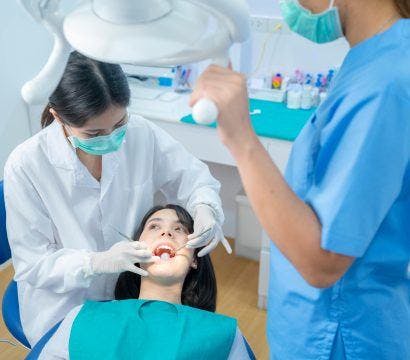You might be able to thank your folks for your striking good looks, but have you ever wondered if you inherited your smile from mum and dad too? While many things in your life happen because of your decisions, several outcomes are also because of your family history. For example, you may be genetically predisposed to bad teeth.
This article explores the link between genetics and your teeth. Find out whether you inherited your dental problems from your parents.
7 common teeth problems that may be genetic
Your bad teeth may not completely be the result of poor dental habits. Here are some dental problems that may be hereditary.
Tooth decay
Tooth decay or cavities are largely due to poor dental hygiene and eating habits. However, a PLoS One study states that those with weaker enamel are more susceptible to cavities. Unfortunately, the quality of your enamel depends on genetics.
Gum disease
According to the American Dental Association, a family history of gum disease puts you at risk for gingivitis and other oral issues.
Overlapping teeth
The Japanese may love a cute snaggletooth, but did you know overlapping teeth may be inherited? Your tooth size and shape are dictated by your genes. Unfortunately, these may influence your teeth. For example, large teeth could crowd in your mouth, causing crookedness.
Overbites and underbites
Did you get your dad’s prominent jawline? Your bottom teeth may project beyond your top ones. Several factors affect overbites and underbites, including jaw size and shape, tooth alignment, and the growth patterns of your face. All these factors have a genetic component.
Diastema
Diastema describes the gap between your front teeth. According to the Journal of Clinical Pediatric Dentistry, a family history of diastema means you’re likely to develop the condition. Other factors that influence diastema include jaw size, tooth size, and the position of your labial frenum (the tissue that connects your upper lip to the gum).
Hyperdontia
Hyperdontia is a condition where you have extra teeth. It usually disrupts dental alignment and function.
Hypodontia
On the other hand, hypodontia refers to the absence of one or more teeth. Like hyperdontia and diastema, it can cause your teeth to shift and misalign.
Other dental conditions that stem from your family tree include enamel hypoplasia (thin enamel) and dentinogenesis imperfecta (brittle teeth). But just because you were born with dental problems doesn’t mean you’re stuck with them.
If your bad teeth have something to do with alignment or overcrowding, ask your orthodontist about ClearCorrect. These virtually invisible aligners are made with a tri-layer ClearQuartz material that consists of two resilient outer shells and an elastomeric inner layer.
ClearCorrect’s high, flat, and unscalloped trimline has also been proven to optimise force transmission for more accurate tooth movement and enhanced root control. Visit the ClearCorrect website to learn more about this tailor-fitted alignment solution. And take this online smile assessment to find out if you’re a candidate.
How genetics impacts oral health
Not brushing your teeth, forgetting to floss, and other poor dental hygiene habits remain the primary causes of poor oral health. However, science says genetics plays a role in specific conditions, such as tooth decay and crooked teeth.
Here are some ways your bad teeth might have been passed down to you and what to do to outwit your genes.
How tooth enamel forms
Research explains that tooth discolouration stems from genes and environmental factors. However, the way the enamel is formed is mainly genetic. Those with naturally thinner enamel are more prone to yellowing, sensitivity, and decay – thanks to wear and tear from rough brushing or age.
The brilliance of your smile is determined as early as in the womb. The tooth enamel’s development can be affected by certain medications like the antibiotic tetracycline or excess fluoride your mother took while you were in utero.
Still, you can’t blame your parents completely because external factors that you can control as an adult, such as smoking or consuming specific foods, play bigger roles in tooth discolouration. Brush your teeth regularly and avoid sugary, acidic, or staining food items.
Resistance to tooth decay
There are some things that you have control of and are unrelated to genetics. For instance, tooth decay is largely due to environmental factors – not genes! Cavities form when you consume food high in sugar that turns into acid. These acids produce bacteria that erodes the enamel and causes cavities.
Bacteria on the teeth doesn’t appear until much later after a baby’s first teeth sprout.
One study in the Journal of Microbiological Methods compares the number of bacteria in identical and fraternal twins. Although genetic links in bacteria were found in the DNA, none were associated with tooth decay.
A genetic factor that might affect how prone your teeth are to tooth decay is your immune system. Those with weaker immune systems are more likely to have cavities and gum disease because of their inability to ward off infections. Strong teeth come from a strong body, so it pays to take care of yourself.
Ability to produce saliva
Saliva helps rinse bacteria and plaque from the mouth. It also balances pH levels in the mouth and delivers vital minerals like fluoride, calcium, and phosphate to your teeth.
However, individuals with certain gene variants produce more saliva than others. Moreover, women also generate less saliva than men.
Crooked teeth
A paper in the International Journal of Anthropology confirms genetic and environmental factors contribute to crooked teeth. Misalignment can be influenced by the number and size of your teeth, the shape of your jaw, and even how you chew.
While most are genetic, other behaviours that begin at birth, such as thumb sucking and pushing your tongue against the teeth, could also cause crooked teeth.
How you can overcome genetics
While you can’t do much about your eye colour and large pores, there are some steps you can take to minimise and prevent genetically “bad teeth” from affecting your smile.
When it comes down to it, prioritising your oral hygiene and seeing your dentist regularly are just some ways your teeth can dodge the gene bullet.
Maintain good oral hygiene.

Brush and floss your teeth twice a day. Consider using mouthwash if saliva production is a problem for you. To protect your teeth from tooth decay, increase fluoride exposure. It doesn’t have to be just in your toothpaste. You might get an extra boost of fluoride from your water supply or certain oral treatments.
Be careful not to let your little ones get too much of it. An excessive amount of fluoride in children can result in dental fluorosis, which appears as spots or marks on the teeth in the early stages of development.
Make healthy diet choices.
Although you don’t have to avoid sweets altogether, you should limit your intake of sugary foods. To satisfy your sweet tooth, grab some fruit instead. Crunchy, fibre-rich fruits and vegetables can help clean your teeth and give them a good scrubbing due to their high water content.
You know that drinking water is good for your overall health, but apart from keeping you hydrated, chugging H20 throughout the day will also help hydrate your mouth and rinse out any leftover food particles or acids from your meals.
Straighten crooked teeth.

Whether it is inherited or due to environmental factors, there’s no harm in getting treatment for your crooked teeth so you can flash them a grin that will have them saying it runs in the family.
And the great news is that you can make your smile look completely natural. ClearCorrect premier dental aligners will make your straight teeth look as if you were born with them. Its medical-grade, proprietary plastic has stain-proof properties that have proved to be more resistant than other leading brands.
Bad teeth revive the age-old discussion of nature versus nurture. For the lucky few, a set of strong, evenly spaced teeth is something they were born with. But just because your pearly whites are more unruly doesn’t mean you should just sit back and let the plaque grow. Maintaining good oral hygiene, a healthy diet, and following recommendations from your dentist will ensure you make the most of the genetics you have. The bottom line is no matter what type of teeth you have, you can have a great smile with optimal dental care.
References:
Di Bella, J. M., Bao, Y., Gloor, G. B., Burton, J. P., & Reid, G. (2013). High throughput sequencing methods and analysis for microbiome research. Journal of Microbiological Methods, 95(3), 401–414.
Gomez, A., Espinoza, J. L., Harkins, D. M., Leong, P., Saffery, R., Bockmann, M., Torralba, M., Kuelbs, C., Kodukula, R., Inman, J. M., Hughes, T., Craig, J. M., Highlander, S. K., Jones, M. D., Dupont, C. L., & Nelson, K. E. (2017). Host Genetic Control of the Oral Microbiome in Health and Disease. Cell Host & Microbe, 22(3), 269-278.e3.
Hattab, F. N., Qudeimat, M. A., & Al-Rimawi, H. S. (1999). Dental Discoloration: An Overview. Journal of Esthetic and Restorative Dentistry, 11(6), 291–310.
Simon, J. B., DiCarlo, L. M., Kruger, C., Johnson, W. D., Kappen, C., & Richards, B. K. (2015). Gene expression in salivary glands: effects of diet and mouse chromosome 17 locus regulating macronutrient intake. Physiological Reports, 3(2), e12311.
Townsend, G., Hughes, T., & Richards, L. (2006). Gaining New Insights into How Genetic Factors Influence Human Dental Development by Studying Twins. International Journal of Anthropology, 21(1), 67–74.



